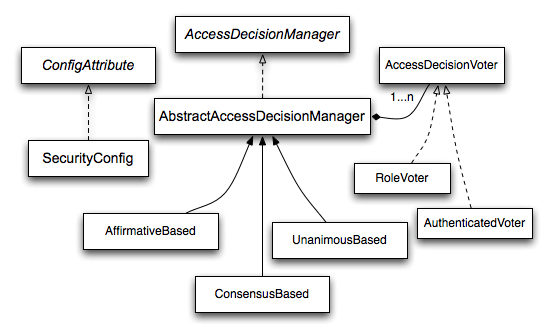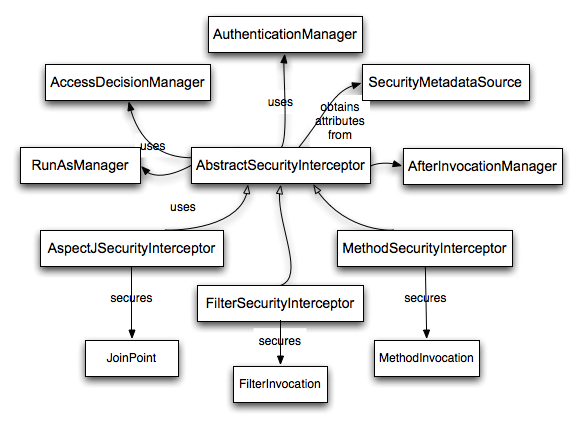最近项目需要用到spring security的权限控制,故花了点时间简单的去看了一下其权限控制相关的源码(版本为4.2)。
accessdecisionmanager
spring security是通过accessdecisionmanager进行授权管理的,先来张官方图镇楼。

accessdecisionmanager
accessdecisionmanager 接口定义了如下方法:
|
1
2
3
4
5
6
7
|
//调用accessdecisionvoter进行投票(关键方法)void decide(authentication authentication, object object, collection<configattribute> configattributes) throws accessdeniedexception, insufficientauthenticationexception;boolean supports(configattribute attribute);boolean supports(class clazz); |
接下来看看它的实现类的具体实现:
affirmativebased
|
1
2
3
4
5
6
7
8
9
10
11
12
13
14
15
16
17
18
19
20
21
22
23
24
25
26
27
28
29
30
31
32
33
34
35
36
|
public void decide(authentication authentication, object object, collection<configattribute> configattributes) throws accessdeniedexception { int deny = 0; for (accessdecisionvoter voter : getdecisionvoters()) { //调用accessdecisionvoter进行vote(我们姑且称之为投票吧),后面再看vote的源码。 int result = voter.vote(authentication, object, configattributes); if (logger.isdebugenabled()) { logger.debug("voter: " + voter + ", returned: " + result); } switch (result) { case accessdecisionvoter.access_granted://值为1 //只要有voter投票为access_granted,则通过 return; case accessdecisionvoter.access_denied://值为-1 deny++; break; default: break; } } if (deny > 0) { //如果有两个及以上accessdecisionvoter(姑且称之为投票者吧)都投access_denied,则直接就不通过了 throw new accessdeniedexception(messages.getmessage( "abstractaccessdecisionmanager.accessdenied", "access is denied")); } // to get this far, every accessdecisionvoter abstained checkallowifallabstaindecisions();} |
通过以上代码可直接看到affirmativebased的策略:
- 只要有投通过(access_granted)票,则直接判为通过。
- 如果没有投通过票且反对(access_denied)票在两个及其以上的,则直接判为不通过。
unanimousbased
|
1
2
3
4
5
6
7
8
9
10
11
12
13
14
15
16
17
18
19
20
21
22
23
24
25
26
27
28
29
30
31
32
33
34
35
36
37
38
39
40
41
42
43
44
45
46
47
48
49
|
public void decide(authentication authentication, object object, collection<configattribute> attributes) throws accessdeniedexception { int grant = 0; int abstain = 0; list<configattribute> singleattributelist = new arraylist<configattribute>(1); singleattributelist.add(null); for (configattribute attribute : attributes) { singleattributelist.set(0, attribute); for (accessdecisionvoter voter : getdecisionvoters()) { //配置的投票者进行投票 int result = voter.vote(authentication, object, singleattributelist); if (logger.isdebugenabled()) { logger.debug("voter: " + voter + ", returned: " + result); } switch (result) { case accessdecisionvoter.access_granted: grant++; break; case accessdecisionvoter.access_denied: //只要有投票者投反对票就立马判为无权访问 throw new accessdeniedexception(messages.getmessage( "abstractaccessdecisionmanager.accessdenied", "access is denied")); default: abstain++; break; } } } // to get this far, there were no deny votes if (grant > 0) { //如果没反对票且有通过票,那么就判为通过 return; } // to get this far, every accessdecisionvoter abstained checkallowifallabstaindecisions();} |
由此可见unanimousbased的策略:
- 无论多少投票者投了多少通过(access_granted)票,只要有反对票(access_denied),那都判为不通过。
- 如果没有反对票且有投票者投了通过票,那么就判为通过。
consensusbased
|
1
2
3
4
5
6
7
8
9
10
11
12
13
14
15
16
17
18
19
20
21
22
23
24
25
26
27
28
29
30
31
32
33
34
35
36
37
38
39
40
41
42
43
44
45
46
47
48
49
50
51
52
53
54
55
56
57
58
|
public void decide(authentication authentication, object object, collection<configattribute> configattributes) throws accessdeniedexception { int grant = 0; int deny = 0; int abstain = 0; for (accessdecisionvoter voter : getdecisionvoters()) { //配置的投票者进行投票 int result = voter.vote(authentication, object, configattributes); if (logger.isdebugenabled()) { logger.debug("voter: " + voter + ", returned: " + result); } switch (result) { case accessdecisionvoter.access_granted: grant++; break; case accessdecisionvoter.access_denied: deny++; break; default: abstain++; break; } } if (grant > deny) { //通过的票数大于反对的票数则判为通过 return; } if (deny > grant) { //通过的票数小于反对的票数则判为不通过 throw new accessdeniedexception(messages.getmessage( "abstractaccessdecisionmanager.accessdenied", "access is denied")); } if ((grant == deny) && (grant != 0)) { //this.allowifequalgranteddenieddecisions默认为true //通过的票数和反对的票数相等,则可根据配置allowifequalgranteddenieddecisions进行判断是否通过 if (this.allowifequalgranteddenieddecisions) { return; } else { throw new accessdeniedexception(messages.getmessage( "abstractaccessdecisionmanager.accessdenied", "access is denied")); } } // to get this far, every accessdecisionvoter abstained checkallowifallabstaindecisions();} |
由此可见,consensusbased的策略:
- 通过的票数大于反对的票数则判为通过。
- 通过的票数小于反对的票数则判为不通过。
- 通过的票数和反对的票数相等,则可根据配置allowifequalgranteddenieddecisions(默认为true)进行判断是否通过。
到此,应该明白affirmativebased、unanimousbased、consensusbased三者的区别了吧,spring security默认使用的是affirmativebased, 如果有需要,可配置为其它两个,也可自己去实现。
投票者
以上accessdecisionmanager的实现类都只是对权限(投票)进行管理(策略的实现),具体投票(vote)的逻辑是通过调用accessdecisionvoter的子类(投票者)的vote方法实现的。spring security默认注册了rolevoter和authenticatedvoter两个投票者。下面来看看其源码。
accessdecisionmanager
|
1
2
3
4
5
|
boolean supports(configattribute attribute);boolean supports(class<?> clazz);//核心方法,此方法由上面介绍的的accessdecisionmanager调用,子类实现此方法进行投票。int vote(authentication authentication, s object, collection<configattribute> attributes); |
rolevoter
|
1
2
3
4
5
6
7
8
9
10
11
12
13
14
15
16
17
18
19
20
21
22
23
24
25
26
27
28
29
30
31
32
33
34
35
36
37
38
39
40
|
private string roleprefix = "role_";//只处理role_开头的(可通过配置roleprefix的值进行改变)public boolean supports(configattribute attribute) { if ((attribute.getattribute() != null) && attribute.getattribute().startswith(getroleprefix())) { return true; } else { return false; }}public int vote(authentication authentication, object object, collection<configattribute> attributes) { if(authentication == null) { //用户没通过认证,则投反对票 return access_denied; } int result = access_abstain; //获取用户实际的权限 collection<? extends grantedauthority> authorities = extractauthorities(authentication); for (configattribute attribute : attributes) { if (this.supports(attribute)) { result = access_denied; // attempt to find a matching granted authority for (grantedauthority authority : authorities) { if (attribute.getattribute().equals(authority.getauthority())) { //权限匹配则投通过票 return access_granted; } } } } //如果处理过,但没投通过票,则为反对票,如果没处理过,那么视为弃权(access_abstain)。 return result;} |
很简单吧,同时,我们还可以通过实现accessdecisionmanager来扩展自己的voter。但是,要实现这个,我们还必须得弄清楚attributes这个参数是从哪儿来的,这个是个很关键的参数啊。通过一张官方图能很清晰的看出这个问题来:

接下来,就看看accessdecisionmanager的调用者abstractsecurityinterceptor。
abstractsecurityinterceptor
|
1
2
3
4
5
6
7
8
9
10
11
12
13
14
15
16
17
18
19
20
21
22
23
24
25
26
27
|
...//上面说过默认是affirmativebased,可配置private accessdecisionmanager accessdecisionmanager;...protected interceptorstatustoken beforeinvocation(object object) { ... //抽象方法,子类实现,但由此也可看出configattribute是由securitymetadatasource(实际上,默认是defaultfilterinvocationsecuritymetadatasource)获取。 collection<configattribute> attributes = this.obtainsecuritymetadatasource() .getattributes(object); ... //获取当前认证过的用户信息 authentication authenticated = authenticateifrequired(); try { //调用accessdecisionmanager this.accessdecisionmanager.decide(authenticated, object, attributes); } catch (accessdeniedexception accessdeniedexception) { publishevent(new authorizationfailureevent(object, attributes, authenticated, accessdeniedexception)); throw accessdeniedexception; } ... }public abstract securitymetadatasource obtainsecuritymetadatasource(); |
以上方法都是由abstractsecurityinterceptor的子类(默认是filtersecurityinterceptor)调用,那就再看看吧:
filtersecurityinterceptor
|
1
2
3
4
5
6
7
8
9
10
11
12
13
14
15
16
17
18
19
20
21
22
23
24
25
26
27
28
29
30
31
32
33
34
35
36
37
38
|
...//securitymetadatasource的实现类,由此可见,可通过外部配置。这也说明我们可以通过自定义securitymetadatasource的实现类来扩展出自己实际需要的configattributeprivate filterinvocationsecuritymetadatasource securitymetadatasource; ...//入口public void dofilter(servletrequest request, servletresponse response, filterchain chain) throws ioexception, servletexception { filterinvocation fi = new filterinvocation(request, response, chain); //关键方法 invoke(fi);}public void invoke(filterinvocation fi) throws ioexception, servletexception { if ((fi.getrequest() != null) && (fi.getrequest().getattribute(filter_applied) != null) && observeonceperrequest) { // filter already applied to this request and user wants us to observe // once-per-request handling, so don't re-do security checking fi.getchain().dofilter(fi.getrequest(), fi.getresponse()); } else { // first time this request being called, so perform security checking if (fi.getrequest() != null) { fi.getrequest().setattribute(filter_applied, boolean.true); } //在这儿调用了父类(abstractsecurityinterceptor)的方法, 也就调用了accessdecisionmanager interceptorstatustoken token = super.beforeinvocation(fi); try { fi.getchain().dofilter(fi.getrequest(), fi.getresponse()); } finally { super.finallyinvocation(token); } //完了再执行(父类的方法),一前一后,aop无处不在啊 super.afterinvocation(token, null); }} |
好啦,到此应该对于spring security的权限管理比较清楚了。看完这个,不知你是否能扩展出一套适合自己需求的权限需求来呢,如果还不太清楚,那也没关系,下篇就实战一下,根据它来开发一套自己的权限体系。
以上就是本文的全部内容,希望对大家的学习有所帮助,也希望大家多多支持服务器之家。
原文链接:http://www.cnblogs.com/dongying/p/6106855.html















